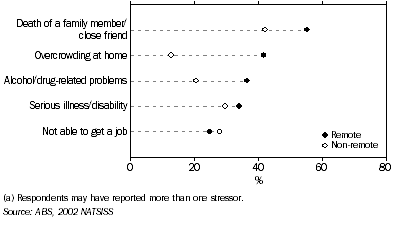Major life changes that alter a person’s social roles and relationships, such as divorce, serious illness, or the death of a loved one, can increase susceptibility to stress, especially when several of these changes occur within a brief time period (Bryce 2001). Chronic life stress is detrimental to a person's health as it elevates the risk of developing depression, diabetes, high cholesterol and high blood pressure (Wilkinson & Marmot 2003).
In 2002, 82% of Indigenous people aged 15 years or over reported experiencing at least one life stressor in the last 12 months. The most common types of stressors reported were the death of a family member or close friend (46%), serious illness or disability (31%) and inability to get a job (27%). However, for those living in remote areas the most frequently reported stressors were death of a family member or close friend (55%), overcrowding at home (42%) and alcohol and drug-related problems (37%) (graph 8.8).
8.8 Selected personal stressors(a) in the last 12 months, Indigenous persons aged 15 years or over - 2002

High rates of multiple life stressors were reported by Aboriginal and Torres Strait Islander people in 2002. Just under one-half (44%) reported experiencing at least three life stressors in the last 12 months and one in eight (12%) reported experiencing at least seven life stressors during this time period. Multiple stressors were particularly prevalent among those living in remote areas, who were twice as likely as those living in non-remote areas to have experienced seven or more stressors in the last year (20% compared with 9%).
Exposure to life stressors was associated with poorer self-assessed health and higher rates of health risk behaviour. Indigenous people who had reported experiencing at least one stressor in the last 12 months were more likely than those who had not experienced a stressor to report being in fair or poor health (25% compared with 17%) and were less likely to report being in excellent or very good health (42% compared with 54%). They were also more likely to have a disability or long-term health condition (38% compared with 29%), to regularly smoke (50% compared with 41%), to have recently used illicit substances (24% compared with 14% in non-remote areas) and to have been a victim of physical or threatened violence in the last 12 months (28% compared with 8%).
When age differences between the Indigenous and non-Indigenous populations were taken into account, Indigenous people aged 18 years or over were almost one and a half times as likely as non-Indigenous people to report having experienced at least one stressor in 2002. However the types of stressors experienced by both Indigenous and non-Indigenous people were similar, with serious illness or disability, death and inability to get a job being the three most frequently reported stressors by non-Indigenous people in 2002.
 Print Page
Print Page
 Print All
Print All